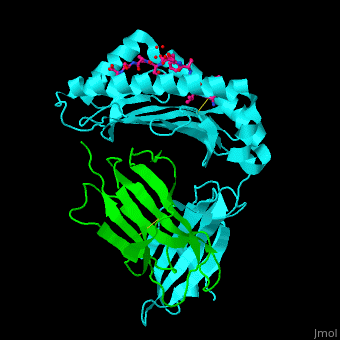Major histocompatibility complex
From Proteopedia
(Difference between revisions)
| Line 2: | Line 2: | ||
__TOC__ | __TOC__ | ||
== Function == | == Function == | ||
| - | ''' Major Histocompatibility Complex''' (MHC) molecules bind peptides derived from degraded proteins and present these peptides on the surface of the cell. T- | + | ''' Major Histocompatibility Complex''' (MHC) molecules bind peptides derived from degraded proteins and present these peptides on the surface of the cell. Cytotoxic T-lymphocytes or helper T cells recognize the MHC:peptide complex on the surface of the cell and trigger an immune response if the presented peptide (antigen) is suggestive of a pathogenic or foreign protein. In this way, MHC molecules allow for immune system detection of protein presence, making them an essential part of the organism’s immune system. MHC molecules are divided into Class I and Class II molecules based on the types of cells that typically express them and the types of peptides they typically bind. |
<br /> | <br /> | ||
* '''MHC class I''' ([[Major Histocompatibility Complex Class I]]) are found in all nucleated cells. These cell surface proteins display peptides from cellular intrinsic proteins<ref>PMID:18675588</ref>. For more details see <br /> | * '''MHC class I''' ([[Major Histocompatibility Complex Class I]]) are found in all nucleated cells. These cell surface proteins display peptides from cellular intrinsic proteins<ref>PMID:18675588</ref>. For more details see <br /> | ||
| - | *[[Effect of HCMV on Major Histocompatibility Complex Class I]]<br /> | + | **[[Effect of HCMV on Major Histocompatibility Complex Class I]]<br /> |
| - | *[[MR1 Binds Vitamin Metabolites]].<br /> | + | **[[MR1 Binds Vitamin Metabolites]].<br /> |
* '''MHC class II''' are found in professional antigen-presenting cells like macrophages. These cell surface proteins display peptides from cellular extrinsic proteins<ref>PMID:15120183</ref>.<br /> | * '''MHC class II''' are found in professional antigen-presenting cells like macrophages. These cell surface proteins display peptides from cellular extrinsic proteins<ref>PMID:15120183</ref>.<br /> | ||
| - | For MHC class II interactions with T-cell receptor and gliadin peptide see [[SP3.4-TCR-HLA-DQ8-α-1-gliadin complex]]. | + | For information on MHC class II interactions with T-cell receptor and gliadin peptide see [[SP3.4-TCR-HLA-DQ8-α-1-gliadin complex]]. |
== Structural highlights == | == Structural highlights == | ||
Revision as of 20:10, 21 July 2020
| |||||||||||
References
- ↑ Raghavan M, Del Cid N, Rizvi SM, Peters LR. MHC class I assembly: out and about. Trends Immunol. 2008 Sep;29(9):436-43. doi: 10.1016/j.it.2008.06.004. PMID:18675588 doi:http://dx.doi.org/10.1016/j.it.2008.06.004
- ↑ Holling TM, Schooten E, van Den Elsen PJ. Function and regulation of MHC class II molecules in T-lymphocytes: of mice and men. Hum Immunol. 2004 Apr;65(4):282-90. PMID:15120183 doi:http://dx.doi.org/10.1016/j.humimm.2004.01.005
- ↑ Liu J, Chen KY, Ren EC. Structural insights into the binding of hepatitis B virus core peptide to HLA-A2 alleles: Towards designing better vaccines. Eur J Immunol. 2011 Jul;41(7):2097-106. doi: 10.1002/eji.201041370. PMID:21538979 doi:10.1002/eji.201041370
Proteopedia Page Contributors and Editors (what is this?)
Michal Harel, Joel L. Sussman, Alexander Berchansky, Tihitina Y Aytenfisu, Eric Martz, Sandra B. Gabelli

